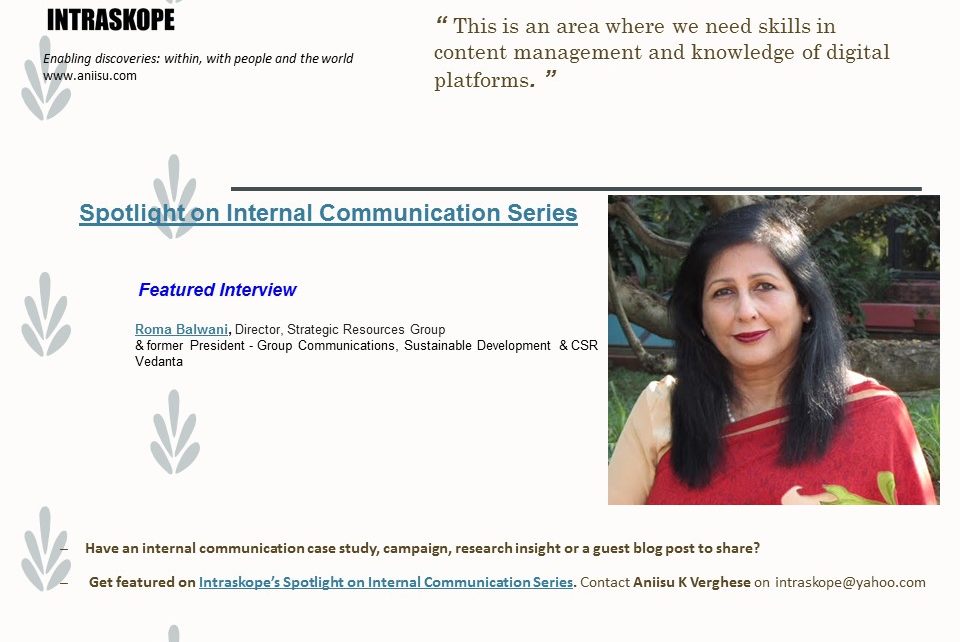Can internal communication influence behavioral change among employees? Is it possible to spur innovation and creativity?
The next edition of Intraskope’s Spotlight on Internal Communication Series features Roma Balwani, Director, Strategic Resources Group and former President – Group Communications, Sustainable Development & CSR and member – Group Executive Committee, Vedanta. Roma shares how internal communication is not just about creating strong relationships and collaboration across all levels in the organizations, it also improves out-of-the-box thinking and problem solving.
Looking back at her three decade long career she draws on her experience as a communication leader at companies such as Mahindra and Vedanta to discuss tips and pointers relevant for internal communicators.
Read on to know more.
Interview
- What does internal communication mean to you?
Internal communication builds a robust platform for shared understanding and relationships in an organization. It is the manner in which an company interacts with its people. It is inherent to the culture of the organization. Communication aimed at the workforce manifests itself multi-fold, helping them grasp and engage with people at all levels and building the organization’s credibility externally.
- How is it practiced in your organization?
Technology plays a large role in our connected world. Every organization can create a shared destiny by co-creating communication by leveraging new age tools. One such example which I can share if from my previous employer where we leveraged technology – the Mahindra Group. Innovation was viewed as a potent tool to create one of the most robust knowledge networks. We graduated from the usual intranet and its use as an information tool, to a video based e-zine that visually connected the Mahindra members globally. Anand Mahindra, Chairman – Mahindra Group appreciated innovative ways and it led to us creating the Mahindra Innovation Awards that celebrated innovation, the successes and failures. An award for failure too is celebrated as a mark of respect and it spurs a ‘can do’ spirit within the organization.
- Please share an example/campaign that you are personally proud of working on and that made a significant impact to your organization.
An example of positive impact through transparent communication is the introduction of Facebook at Workplace at Vedanta. This lead to the Chairman interacting freely and sharing his thoughts with all his employees. Individual functions use it as a group tool to interact informally.
Most importantly, leadership got to know the pulse of employees and understood, empathized & related to issues. He was able to address them before they become a challenge or eroded trust.
Vedanta raises awareness on inculcating a zero-harm culture, highlighting the priority towards the safety of the employees. Every leader echoed the importance of a zero-harm workplace at a business, leadership and human perspective, in all forms of communications. The company followed a global benchmarking safety standard at the work environment and related to infrastructure. The adoption of a robust approach to hazard identification and risk assessment studies, which is conducted phase-by-phase were amplified through workshops, in presentations, video messages from the leadership and in every activity, event or celebrations conducted for the workforce. This has resulted in a significant drop in the number of fatalities, to seven this year, from twelve in FY 2015-16 and nineteen in FY 2013-14.
- What is the biggest challenge you face while going about managing internal communication?
Leveraging digital mediums that can be a powerful approach to facilitate a collaborative culture at work. The technology platform replaces traditional forms of feedback mechanisms while making it transparent. That mindset change is never an easy task.
- What according to you is the biggest opportunity that internal communicators have?
Creating an army of brand ambassadors who are equipped with information about the organization, feel engaged and empowered to create a connection externally.
- How can internal communicators add more value to the business?
When they can raise levels of motivation among employees which in turn impacts productivity, can tranform organizations and measure success.
- What is your advice for people who are keen to join internal communication and make a career? What skills must they have or develop?
This is an area where we need skills in content management and knowledge of digital platforms. HR professionals with their expertise can collaborate with the internal communications team not only to create robust internal engagement but leverage it for talent retention.
Case Study
To have a paradigm shift in communication expects one to change perceptions of talent and manage engagement among middle managers, the largest chunk of employees in most organizations.
Internal communication is handled by communications team and today the biggest challenge the team faces is information overload. In the VUCA world, managing content flow, aligning the potential or latent talent of employees to enhance their career, or track their growth. Most importantly it develops their leadership potential and commitment to the organization.
Recently I curated a unique leadership event, ‘Leading from Behind’’. It uses byte-size communication through a proprietary app to engage middle management and evaluate their performance objectively every day.
The organization then conducted an anonymous survey across in 180 companies across 13 industries and 5,300 middle managers responded. The findings showed that there is an employee disconnect with corporate India’s human capital development efforts.
Internal communications can play a strategic role and collaborate with their HR teams to create a learning culture. So learning has to be continuous and it should be app based. So technology plays an important role. This intervention has been adopted by forward looking companies with internal communications platforms motivating managers to perform better while recognizing effort through effective rewards.
Mahindra Rise Awards is one such manifestation of celebrating middle managers’achievements who are not only great performers – they also leverage technology and innovation at work. With the internal communication and HR teams partnering closely, they create an army of young leaders who not only retain talent but focus on their own development.
I’d like to end with a quote from Nelson Mandela’s famous book – Long Road to Success;
“Lead from the back — and let others believe they are in front”
Missed previous stories from organizations featured on the Intraskope’s Spotlight on Internal Communication Series? Look them up here – Infosys, SOBHA Ltd., ICICI Securities, First Advantage, CK Birla Group, TVS Motors, GE, Suzlon, Tata Sons, Percept, Knight Frank and TCS Europe.
If you are an internal communication practitioner working in a firm or a not-for-profit and have an internal communication case study, campaign, research insight or a guest blog post to share please contact me on intraskope@yahoo.com
You can also visit my website www.intraskope.com and You Tube channel to know more about my work.



